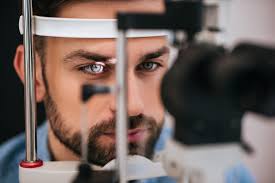
Because diabetics are at an increased risk of developing vision problems, it is important that all diabetics regularly see an optometrist for an eye exam. There are elements to a diabetic eye exam that differ from a traditional eye exam and are designed to specifically address the needs of those with diabetes and prevent diabetic eye diseases. Continue reading below for more information about diabetic eye exams.

The content below has been provided by Dr. Cheryl Stoker, OD, and is medically reviewed for accuracy. Dr. Stoker is an excellent resource for information about diabetic eye care and health as she is herself a diabetic. Therefore, Dr. Stoker has a unique and experienced perspective for an eye care professional working with diabetics on maintaining their health. Some links have been added to audio transcripts to provide access to relevant resources or information.
Table of Contents:
Click on a question below to be taken directly to that answer and content.
- What is a diabetic eye exam, what should I expect from a diabetic eye exam, and what makes it different than just your typical eye exam?
- How often should I get a diabetic eye exam?
- If I’m Prediabetic do I still need an eye exam?
- Will my eyes be dilated for a Diabetic Eye Exam?
If you have questions about diabetic eye exams or diabetic eye care, or if you need to schedule an exam, contact us through the form below. Otherwise, read on below the form to learn about diabetic eye exams.
What is a diabetic eye exam, what should I expect from a diabetic eye exam, and what makes it different than just your typical eye exam?
Answer provided by Dr. Cheryl Stoker. Transcript included below.
Dr. Cheryl Stoker, OD:
The diabetic eye exam is real close to a typical eye exam because we do much of the same things as a regular eye exam. The vision’s checked. We check to see what you’re seeing. We refract you to see if your glasses have changed or if you need glasses or along those lines. We also check your eye pressures because like I said, diabetes, you’re at high risk for glaucoma and that’s what glaucoma is is due to increased eye pressures. We do that. We also dilate the eyes, and we do this for regular eye exams too, but with diabetics, that’s real important is to have a dilated exam because that’s where we evaluate the retina and we can determine if there is any diabetic retinopathy and how severe it is.
Depending on that, then we may do further testing. We may take what we call fundus photos, where we take a picture of the retina and can actually document any diabetic retinopathy, even early stages, like just beginning leakage of the blood vessels, or if it looks like there may be macular edema, we can do another test we call an OCT, which is another way to take a picture of the macula, but it can show us if there is macular edema there. Then we can get the patient to the correct treatment that they need if we do see signs of that. So it’s really basically similar to a regular eye exam, but depending on what the retina looks like, then we decide if there’s further testing and further treatment that needs to be done.
How often should I get a diabetic eye exam?
Answer provided by Dr. Cheryl Stoker. Transcript included below.
Dr. Cheryl Stoker, OD:
Well, diabetics definitely need a yearly eye exam, and that’s the minimum. I’ve worked with lots of diabetic specialists and endocrinologists, and some of them even recommend every six months. I think that would depend on whether there are any signs of diabetic retinopathy, because if there’s early diabetic retinopathy, it can be reversible. Once the patient gets their blood sugar more under control, then some of those early signs like the early leakage of the blood vessels or the little hemorrhages can go away. So if we do see signs of diabetic retinopathy, then we may have the patient come back in six months to dilate them again and to see if those signs are going away, but definitely a minimum of once a year.
If I’m Prediabetic do I still need an eye exam?
It is important to monitor your A1C and blood sugar levels as well as get regular exercise and eat a healthy diet to prevent prediabetes from escalating to diabetes. Even If your doctor has not diagnosed you as diabetic it is still important to get annual eye exams to monitor the health of your eyes. The most important reason for this is due to fluctuations in blood sugars in people who are prediabetic. If your blood sugars are not well controlled, it can be threatening to your eye health and vision before you have been officially diagnosed as diabetic.
Will my eyes be dilated for a Diabetic Eye Exam?
As you prepare for your Diabetic Eye Exam, it is important to know that you will be dilated at your appointment. Dilation is one of the tools that help your ophthalmologist determine the health of your eyes at each appointment. Because the retina tissue is usually not visible under the ophthalmic microscope (also known as the “slit lamp”) under normal conditions due to various visual interferences such as the constricted iris, the only way your ophthalmologist will be able to analyze your retinal tissue is through dilation. Dilation will paralyze the muscle that causes the iris to constrict, making your pupil very large. This creates a window into the eye and allows your doctor to view the retina through a lens. Dilation is very important for diabetic eye exams due to the retina tissue being the most at risk for people with diabetes. It is important to plan to be dilated for your diabetic eye exam and make preparations ahead of time. You can expect dilation to last a few hours after the drops are instilled. When dilated, your near vision will be a bit blurrier than normal and you will be more sensitive to light, so remember to bring your sunglasses!




